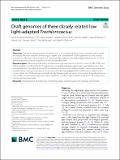| dc.contributor.author | Berta-Thompson, Jessie W. | |
| dc.contributor.author | Thomas, Elaina | |
| dc.contributor.author | Cubillos-Ruiz, Andrés | |
| dc.contributor.author | Hackl, Thomas | |
| dc.contributor.author | Becker, Jamie W. | |
| dc.contributor.author | Coe, Allison | |
| dc.contributor.author | Biller, Steven J. | |
| dc.contributor.author | Berube, Paul M. | |
| dc.contributor.author | Chisholm, Sallie W. | |
| dc.date.accessioned | 2023-02-27T15:09:00Z | |
| dc.date.available | 2023-02-27T15:09:00Z | |
| dc.date.issued | 2023-02-24 | |
| dc.identifier.uri | https://hdl.handle.net/1721.1/148227 | |
| dc.description.abstract | Abstract
Objectives
The marine cyanobacterium Prochlorococcus is a critical part of warm ocean ecosystems and a model for studying microbial evolution and ecology. To expand the representation of this organism’s vast wild diversity in sequence collections, we performed a set of isolation efforts targeting low light-adapted Prochlorococcus. Three genomes resulting from this larger body of work are described here.
Data description
We present draft-quality Prochlorococcus genomes from enrichment cultures P1344, P1361, and P1363, sampled in the North Pacific. The genomes were built from Illumina paired reads assembled de novo. Supporting datasets of raw reads, assessments, and sequences from co-enriched heterotrophic marine bacteria are also provided. These three genomes represent members of the low light-adapted LLIV Prochlorococcus clade that are closely related, with 99.9% average nucleotide identity between pairs, yet vary in gene content. Expanding the powerful toolkit of Prochlorococcus genomes, these sequences provide an opportunity to study fine-scale variation and microevolutionary processes. | en_US |
| dc.publisher | BioMed Central | en_US |
| dc.relation.isversionof | https://doi.org/10.1186/s12863-022-01103-4 | en_US |
| dc.rights | Creative Commons Attribution | en_US |
| dc.rights.uri | https://creativecommons.org/licenses/by/4.0/ | en_US |
| dc.source | BioMed Central | en_US |
| dc.title | Draft genomes of three closely related low light-adapted Prochlorococcus | en_US |
| dc.type | Article | en_US |
| dc.identifier.citation | BMC Genomic Data. 2023 Feb 24;24(1):11 | en_US |
| dc.contributor.department | Massachusetts Institute of Technology. Department of Civil and Environmental Engineering | |
| dc.contributor.department | Massachusetts Institute of Technology. Department of Biology | |
| dc.identifier.mitlicense | PUBLISHER_CC | |
| dc.eprint.version | Final published version | en_US |
| dc.type.uri | http://purl.org/eprint/type/JournalArticle | en_US |
| eprint.status | http://purl.org/eprint/status/PeerReviewed | en_US |
| dc.date.updated | 2023-02-26T04:15:21Z | |
| dc.language.rfc3066 | en | |
| dc.rights.holder | The Author(s) | |
| dspace.date.submission | 2023-02-26T04:15:21Z | |
| mit.license | PUBLISHER_CC | |
| mit.metadata.status | Authority Work and Publication Information Needed | en_US |
